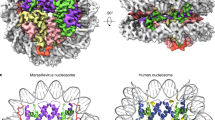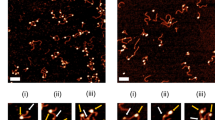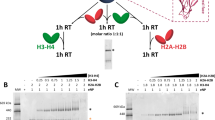Abstract
CHROMATIN has a subunit structure1–5 and each subunit, for which the term nucleosome has been suggested5, has been proposed to consist of two of each of the four histones H2A, H2B, H3 and H4, and 200 base pairs of DNA (ref. 3). Do the histones responsible for generating the nucleosomes bind to specific sequences of the DNA? Heterologous reconstitution experiments showed that the four histones bound to DNA from bacteria or viruses gave rise to the same X-ray diffraction pattern6, the same size of nuclease-resistant DNA fragments7, and the same subunit structure, shown by electron microscopy5, as obtained for native chromatin. These findings suggest that the nucleosomes do not contain specific DNA sequences. This agrees with the apparently random distribution of nucleosomes along adenovirus DNA5. On the other hand, there is evidence that individual histones and polypeptides like polylysine or polyarginine bind preferentially to certain DNA sequences8–10.
This is a preview of subscription content, access via your institution
Access options
Subscribe to this journal
Receive 51 print issues and online access
$199.00 per year
only $3.90 per issue
Buy this article
- Purchase on Springer Link
- Instant access to full article PDF
Prices may be subject to local taxes which are calculated during checkout
Similar content being viewed by others
References
Olins, A. L., and Olins, D. E., Science, 183, 330–332 (1974).
Sahasrabuddhe, C. G., and Van Holde, K. E., J. biol. Chem., 249, 152–156 (1974).
Kornberg, R. D., Science, 184, 868–871 (1974).
Noll, M., Nature, 251, 249–251 (1974).
Oudet, P., Gross-Bellard, M., and Chambon, P., Cell., 4, 281–300 (1975).
Baldwin, J. P., Bradbury, E. M., Butler-Browne, G. S., and Stephens, R. M., FEBS Lett., 34, 133–136 (1973).
Axel, R., Melchior, W., Jr, Sollner-Webb, B., and Felsenfeld, G., Proc. natn. Acad. Sci. U.S.A., 71, 4101–4105 (1974).
Leng, M., and Felsenfeld, G., Proc. natn. Acad. Sci. U.S.A., 56, 1325–1332 (1966).
Clark, R. J. and Felsenfeld, G., Nature new Biol., 240, 226–229 (1972).
Hwan, J. C., Leffak, I. M., Li, H. J., Huang, P. C., and Mura, C., Biochemistry, 14, 1390–1396 (1975).
Streeck, R. E., and Hobom, G., Eur. J. Biochem., 57, 595–606 (1975).
Kornberg, R. D., and Thomas, J. O., Science, 184, 865–868 (1974).
Van der Westhuyzen, D. R., and von Holt, C., FEBS Lett., 14, 333–337 (1971).
Böhm, E. L., et al., FEBS Lett., 34, 217–221 (1973).
Laemmli, U.K., Nature, 227, 680–685 (1970).
Panyim, S., and Chalkley, R., Archs Biochem. Biophys., 130, 337–346 (1969).
D'Anna, J. A., Jr, and Isenberg, I., Biochemistry, 13, 4992–4997 (1974).
Johns, E. W. in Histories and Nucleohistones (edit. by Phililps, D. M. P.), 1–45 (Plenum, London and New York, 1971).
Philippsen, P., Streeck, R. E., and Zachau, H. G., Eur. J. Biochem., 45, 479–488 (1974).
Walz, A., and Pirotta, V., Nature, 254, 118–121 (1975).
Richards, B. M., and Pardon, J. F., Expl Cell Res., 62, 184–196 (1970).
Boseley, P. G., Bradbury, E. M., Butler-Browne, G. S., Carpenter, B. G., and Stephens, R. M., Eur. J. Biochem. (in the press).
Author information
Authors and Affiliations
Rights and permissions
About this article
Cite this article
STEINMETZ, M., STREECK, R. & ZACHAU, H. Nucleosome formation abolishes base-specific binding of histones. Nature 258, 447–450 (1975). https://doi.org/10.1038/258447a0
Received:
Accepted:
Issue Date:
DOI: https://doi.org/10.1038/258447a0
This article is cited by
-
Nucleosome “phasing” and cruciform structures in circular supercoiled pBR322 DNA
Cell Biophysics (1984)
-
Transcriptionally active chromatin
Molecular Biology Reports (1983)
-
Are the bonds between histone fraction and DNA of different strengths?
Bulletin of Experimental Biology and Medicine (1980)
-
Lethal effect of protamine and histone on competent Bacillus subtilis cells
Molecular and General Genetics MGG (1979)
Comments
By submitting a comment you agree to abide by our Terms and Community Guidelines. If you find something abusive or that does not comply with our terms or guidelines please flag it as inappropriate.



